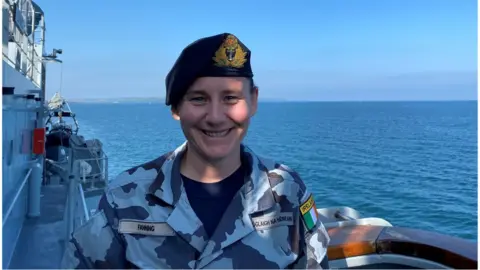 Grace Fanning
Grace FanningGrace Fanning wanted to be a farmer, but her mother said there were neither jobs nor money in agriculture, so she should become a teacher.
Instead, she joined the navy.
The County Carlow native is now the captain of LÉ Róisín, an off-shore patrol vessel and one of nine ships in the fleet of the Irish Naval Service, which is marking its 75th anniversary.
“At the time, whatever my mam said she wanted me to do, I wouldn’t do,” she says.
“I just thought the navy was really cool and really interesting.
“I thought I would go down and get experience, and 20 years later, I’m still here.”
Service vessels will berth in Dublin and Cork over successive weekends in September and, depending on Covid restrictions, members of the public may be allowed access and learn more about the service’s history.
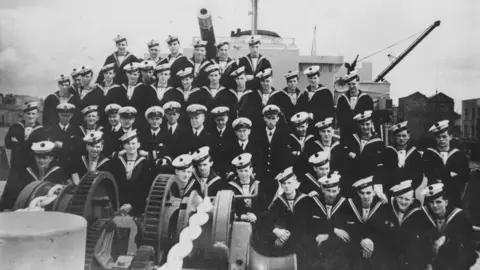 Irish Naval Service
Irish Naval ServiceAlthough Ireland gained independence from the United Kingdom in 1922, it was not until 1938 that the young state gained control of its own waters.
The early task of the Marine and Coastwatching Service was to protect Ireland’s neutrality during World War Two, but in 1946 the service became the permanent maritime component of the Irish Defence Forces.
Over the next 75 years, the service’s responsibilities have expanded to include everything from intelligence gathering, surveillance and maritime interdiction – including drug enforcement – to search and rescue and fishery protection.
Ships have also been used in diplomatic roles with foreign deployments around Europe, the UK, US and Canada, South America and South East Asia.
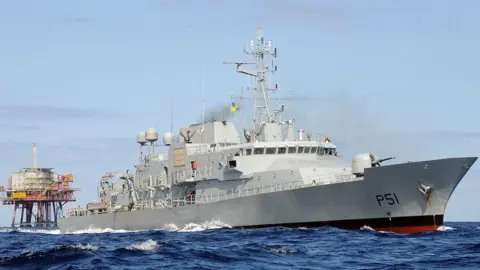 Irish Defence Forces
Irish Defence ForcesLt Cdr Fanning points to cyber security as one of the major threats facing the navy, with the protection of underwater cables on the ocean floor vital to state security.
“That is immense and that is going to be the issue going forward. Not to mention the climate crisis,” she says.
“Seas are getting rougher, as well as the [wild] fires that we’re seeing. There will have to be bigger ships to be able to act on a global stage.”
The Irish Navy has also in the past been involved in intercepting and boarding vessels transporting arms bound for Northern Ireland during the Troubles, including the detention of:
- The 300-ton MV Claudia off Helvick Head, County Waterford, in 1973 with weapons from Libya
- The County Kerry-based trawler Marita Ann, stopped near the Skelligs off the Kerry coast in 1994
When BBC News NI spoke to Lt Cdr Fanning, the LÉ Róisín was just days from completing a four-week rotation patrolling Ireland’s waters, which stretch to an area 10 times the size of Ireland.
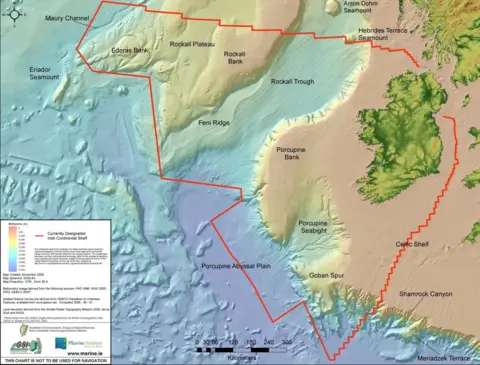 Irish Naval Service
Irish Naval ServiceThe 38-year-old was looking forward to a two-week period at home with her wife and two young children, aged three and one, before a further four-week stint at Róisín’s helm.
As anyone who works at sea will no doubt testify, be it in a military or civilian capacity, it can be a difficult life – long days away from family and friends, living in close quarters with others and often with poor communication links.
“It’s horrendous leaving them [her children],” she says.
“As hard as it is for me, for my wife at home managing a three-year-old and one-year-old, she has it much harder.”
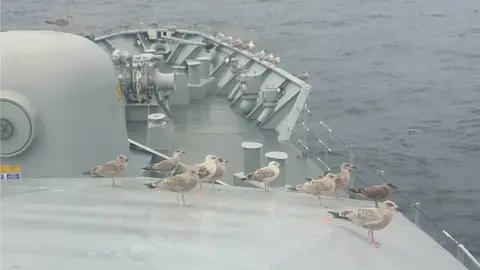 Grace Fanning
Grace FanningHer days at sea begin at 07:00, before she returns to her “bunk” at about 23:00, although she can be called upon overnight if conditions at sea require.
The ship has a crew of 44, with four women – Lt Cdr Fanning, a medic, the navigation officer and an officer under training.
Lt Cdr Fanning recalls that when she joined the navy 20 years ago, colleagues would joke that the early days of the service were “wooden ships and iron men”.
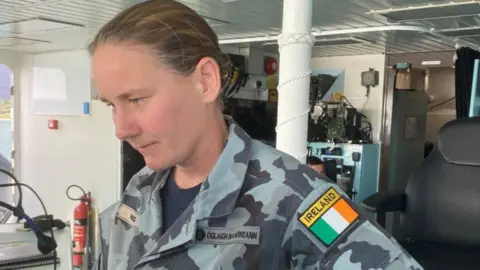 Grace Fanning
Grace FanningThose days are long gone, but women still make up just 6% of Irish Navy personnel, as they were only allowed to join the service from 1995.
Fighting Covid and people-smuggling
One of the Irish Navy’s more high profile roles in recent years was its involvement in helping migrants during various multinational operations in the Mediterranean between 2015 and 2018, during which more than 18,000 migrants were rescued.
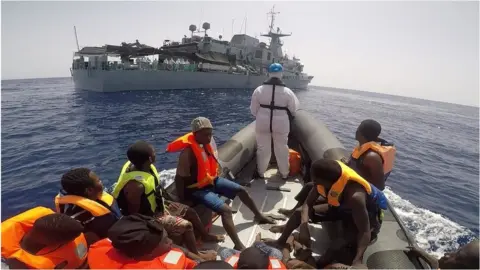 Irish defence forces
Irish defence forces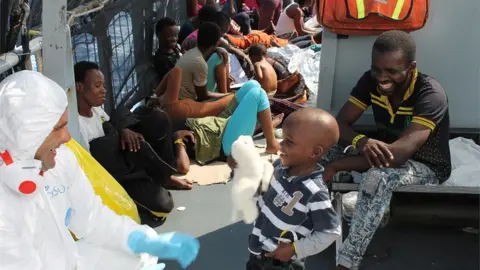 Irish Defence Forces
Irish Defence ForcesMore recently, the Irish Navy has been involved in the fight against Covid-19, supporting the Health Service Executive in 2020 in the early stages of the pandemic by providing personnel and facilities for testing.
That was a role of which Darren McAlinden, from Banbridge, County Down, was particularly proud.
He was stationed on LÉ George Bernard Shaw when it was moored alongside Sir John Rogerson Quay in Dublin last year operating as a testing centre.
“It was really rewarding and made me fell as though I was playing my part regardless of how small that may be,” he says.
Darren, who holds the rank of Leading Supply, joined the navy seven years ago.
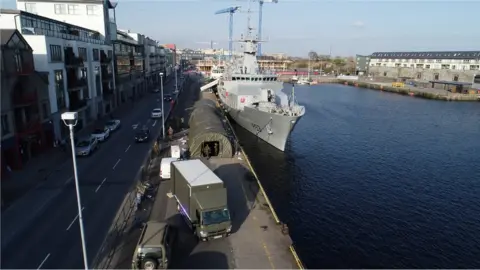 Irish Defence Forces
Irish Defence ForcesHe says he was always interested in joining the Irish Army, but in his early 20s wasn’t in good physical shape.
By the time he improved sufficiently, he was too old to join the army so he set his sights on the navy.
“The life at sea is fantastic – there’s great camaraderie,” he says.
“The first time you see a sunset or a clear night sky, when you’re working late, it’s one of the most amazing things you’ll ever see.
“People go and visit the Cliffs of Moher, but seeing the Cliffs of Moher from the sea is an amazing sight.”
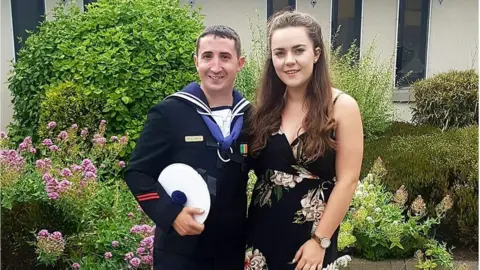 Darren McAlinden
Darren McAlindenHe also has a very personal reason for believing he made the correct career choice as he met his fiancée Lisa, a primary school teacher, after moving to County Cork, where the naval service is headquartered.
Leading Supply McAlinden, who is currently assigned to the navy’s supply division, jokes that friends and neighbours in Banbridge thought he was joining the Royal Navy when he first mentioned he was signing up.
“When I was joining, people were asking when I was moving to Portsmouth. Many said they never knew they [Ireland] had a navy,” he recalls.
“That really changed after the humanitarian missions in the Med. The profile got a lot bigger.”
He fondly recalls a visit LÉ Ciara made to Belfast in 2016, when he was serving onboard, and friends and family were able to visit.
“I have friends who are electricians, and they’re great jobs, but they’re not going to take me to their work and show me around.
“For me, to actually take them around and have them interested in what I do, was a great feeling.”
Outstanding challenges
It’s not all plain sailing for the service, though, as it marks its 75th year. It faces challenges beyond those threats posed to the state, chiefly, recruitment and retention.
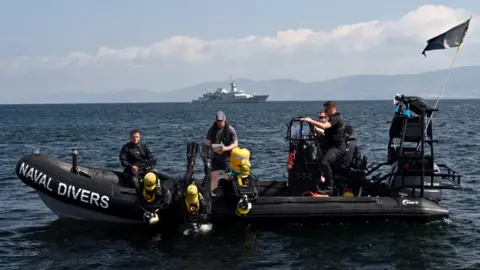 Irish Defence Forces
Irish Defence ForcesOf the nine ships in the fleet, only six are in operation – two are in reserve and one, LÉ Eithne, is getting a refit.
In June, Irish Defence Minister Simon Coveney told the Dáil (Irish parliament) there was a “serious issue to address” but that he was not willing to “compromise on safety standards by under-crewing ships to try to get more ships out”.
Conor King, general secretary of the Representative Association of Commissioned Officers (Raco), tells BBC News NI the Naval Service is more than 20% below strength and that the lost patrol days in 2021 should be of “major concern to government”.
He says better allowances and retention supports are needed to keep personnel, as well as better adherence to EU working time rules.
Independent TD (MP) Cathal Berry, a former Irish Army Ranger, says personnel are being “exploited” because Defence Forces staff are prohibited from going on strike.
“The great irony is that the navy protects the country, but it can’t protect itself,” he says.
‘National security issue’
He says the state needs to pump more money into naval service facilities, improve tax incentives and extend a seagoing bonus scheme to all personnel.
“This isn’t just an industrial relations issue. It is a national security issue,” he adds.
Raco has welcomed an announcement by the government that it intends to invest in a new Multi-Role Vessel (MRV), which will boost the navy’s capabilities and allow it to better provide humanitarian aid at home and overseas.
The navy is trying to increase its numbers. Over recent weeks and months, LÉ Róisín docked in Limerick and Dublin as part of recruitment events, and on Monday of last week, the service took on an extra 34 recruits.
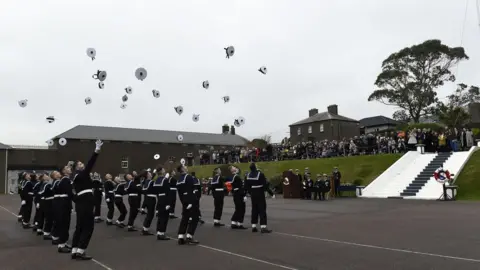 Defence Forces Ireland
Defence Forces IrelandA spokesman says the majority of lost patrol days this year have been due to Covid.
But he adds: “Like many other navies, we are currently losing highly qualified and well trained personnel to private industry. This is common with a buoyant economy outside the navy.”
Despite these challenges, Raco argues the service “consistently punches above its weight”, and senior leaders point to its many successes down through the years.
Reflecting recently on the 75th anniversary, Jacqui McCrum, secretary general of Ireland’s Department of Defence, said the service had and would continue to face challenges.
“The Commission on Defence Forces are currently reviewing all areas of the Defence Forces, including the Naval Service,” she said.
“This valuable process will assist all of us in guiding us towards the next 75 years.”




